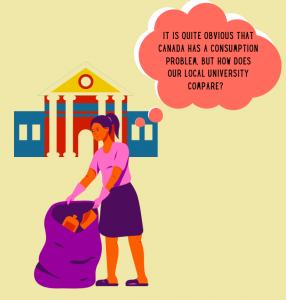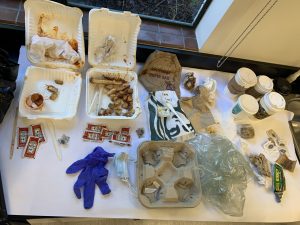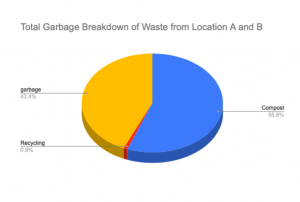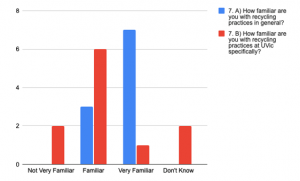TRASH DOES TALK: BUT ONLY IF YOU LISTEN
The subject of waste disposal is not always an appealing one to talk about, but as our waste disposal practices continue to contribute to climate change and pollution; it is more important than ever that we listen to what our trash has to say.
In 2019, the University of Victoria introduced “Sort-It-Out” stations in both indoor and outdoor locations. The implementation of Sort-It-Out stations is a part of the University’s Sustainability Action Plan. As a team, Jessi and I were determined to find out just how effective the Sort-It-Out bins are on UVic campus. Did the introduction of pre-sorted waste bins encourage students to put their garbage in the correct category, therefore increasing waste diversion from the landfill?

By. Freya Harrison
University Of Victoria Sustainability Action Plan Goals:
| 1. Increase waste diversion rate to 82% by December 2021 | |
| 2. Reduce the total amount of waste produced as measured per campus user by 2021 | |
| 3. Incorporate waste reduction education in the residence services’ resident survey or educational planning. |

Students using UVic’s Sort-It-Out stations on campus. (Photo: The University of Victoria) (UVic)
What Does Trash tell us About UVic Students’ Waste Sorting Habits?
In order to determine if and how the Sorting habits of students, staff, and faculty were influenced by pre-sorted Sort-It-Out stations on UVic’s campus, my partner and I decided to collect garbage from several different spots on campus to break down and analyze waste habits. As the second part of our investigation, Jessi and I surveyed people on campus about their waste disposal habits, knowledge of on-campus sorting procedures, and accessibility of specific sorting bins.

Blue Girl Group’s garbage sorting for material analysis.
HMM.. Things Don’t Quite Add up!
After completing our survey data, we realized that what people were saying, and what our garbage samples told us, didn’t quite add up. After sorting through our garbage samples, we found that the majority (55.8%) of the waste found inside the non-recyclable landfill bin was actually compostable, and 0.9% should have been recycled. In total, 56.7% of our total garbage collected was incorrectly sorted into the non-recyclable, landfill waste bin. In comparison to this data, all of our participants in the survey said they were at the very least adequately familiar with UVic’s sorting guidelines. And yet, still over half of our total garbage collected was sorted incorrectly.
Regardless of the inconsistencies between what participants told us, and what our material data confirmed, the participants did demonstrate an overall understanding that UVic’s Sort-It-Out stations are not perfect. 100% of participants agreed there are not enough compost bins on campus. Many of the objects that we found in the landfill bin such as: takeout containers, cutlery, and coffee cups/lids, are in fact compostable. UVic uses biodegradable and plant based plastics for all of its take out containers. These items may have avoided the landfill if there were more compost bins available, and clear effective signage is implemented in the future. Take out containers and cutlery often have very small print designating them as compostable, and the Sort-It-Out station signs are not as detailed as they should be. Detailed signage is extremely important because there are many things that people assume are recyclable but are not. Such as, cardboard pizza boxes or paper coffee cups. Once cardboard has been soaked in grease or coffee it can no longer be recycled, but it can be composted if the item is labeled as such. In fact, if someone were to throw a dirty coffee cup into the paper recycling, all of that clean paper becomes contaminated and cannot be recycled. Based on our data, both ethnographic, and material, the issue of composting correctly on campus is one of the main barriers to increasing waste diversion from the landfill.

Total garbage breakdown of all waste collected from our material data analysis.

Ethnographic survey results of particpants’ familiarity with sorting practices at UVic.
What Does this Mean and Why Should it Matter to You?
With all of our data now compiled and studied, it seems as though UVIC students are in need of a little helping hand when it comes to waste sorting. Food waste is the biggest component in landfills, totaling a whopping 22% of all waste. As food decomposes it releases methane, a greenhouse gas 23x as potent as CO2. Making the importance of proper sorting and sustainable food consumption more important than ever. With the average citizen producing ~1000 lbs of garbage that is sent to the landfill each year, having a designated and effective compost at home is essential to managing food waste (and much easier than you think)! Practicing good sorting habits at home is the key to good sorting habits everywhere. Through education and practice, we can all strive to produce as little waste as possible. Some effective strategies that UVic could apply by listening to student suggestions would include; implementing more compost bins, labeling the bins more clearly, and adding QR codes to stations that have in detail and UVic specific examples of what belongs in each bin. This way students, staff, faculty, and everyone visiting campus can learn and practice proper sorting techniques every day!
Want to learn more? Click here for an informative podcast about some solutions to food waste!
0 Comments